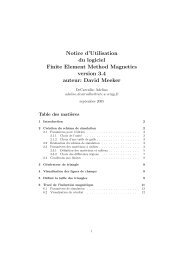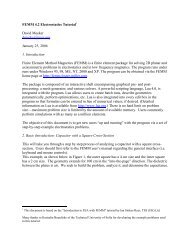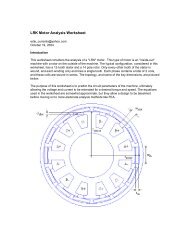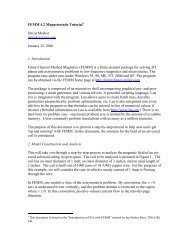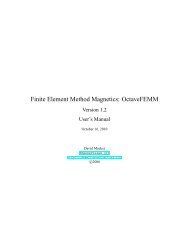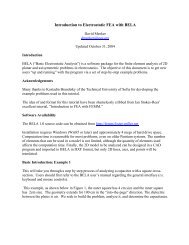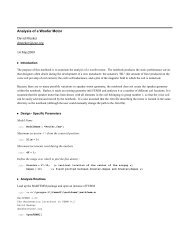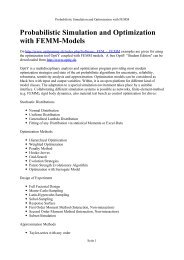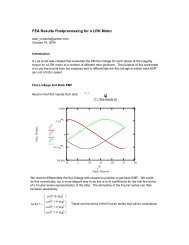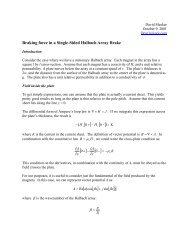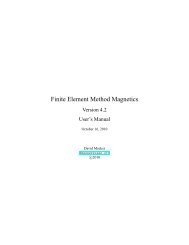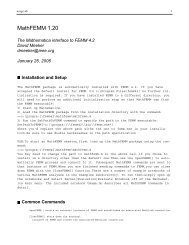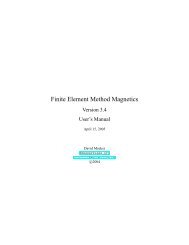Prediction of rotating losses in heteropolar radial magnetic bearings
Prediction of rotating losses in heteropolar radial magnetic bearings
Prediction of rotating losses in heteropolar radial magnetic bearings
You also want an ePaper? Increase the reach of your titles
YUMPU automatically turns print PDFs into web optimized ePapers that Google loves.
<strong>Prediction</strong> <strong>of</strong> <strong>rotat<strong>in</strong>g</strong> <strong>losses</strong> <strong>in</strong> <strong>heteropolar</strong> <strong>radial</strong> <strong>magnetic</strong> bear<strong>in</strong>gs<br />
Abstract: Previously, th<strong>in</strong> plate assumptions have been<br />
used to obta<strong>in</strong> a one-dimensional eddy current model for<br />
predict<strong>in</strong>g the stationary, transformer-type <strong>losses</strong> <strong>in</strong> <strong>magnetic</strong><br />
bear<strong>in</strong>gs built out <strong>of</strong> lam<strong>in</strong>ated material. Us<strong>in</strong>g<br />
similar assumptions as <strong>in</strong> the 1-D eddy current model,<br />
<strong>rotat<strong>in</strong>g</strong> <strong>losses</strong> can be predicted for a lam<strong>in</strong>ated <strong>heteropolar</strong><br />
<strong>radial</strong> <strong>magnetic</strong> bear<strong>in</strong>g. The th<strong>in</strong> plate model <strong>of</strong> <strong>rotat<strong>in</strong>g</strong><br />
<strong>losses</strong> yields a hybrid analytical-boundary element<br />
model that is computationally <strong>in</strong>expensive to implement.<br />
<strong>Prediction</strong>s from this model compare favorably to <strong>losses</strong><br />
experimentally measured <strong>in</strong> rotor run-down tests.<br />
1 Introduction<br />
Classically, eddy currents <strong>in</strong> lam<strong>in</strong>ated transformer cores<br />
have been treated with the model presented by Stoll<br />
[1]. To simplify the eddy current problem, this model<br />
idealizes the eddy current problem as “locally onedimensional<br />
because the penetration distance is small<br />
compared to the other [lam<strong>in</strong>ation] dimensions.” With<br />
this assumption, the eddy current problem is reduced to<br />
a one-dimensional diffusion equation that can be solved<br />
analytically.<br />
The 1-D eddy current model has been applied with<br />
success to transformer cores [2] [3] [4], <strong>magnetic</strong> bear<strong>in</strong>gs<br />
[5] [6] and <strong>magnetic</strong> shield<strong>in</strong>g [7]. In all <strong>of</strong> these cases,<br />
however, eddy currents are <strong>in</strong>duced by variation <strong>of</strong> the<br />
applied <strong>magnetic</strong> field <strong>in</strong> time, rather than by motion.<br />
Because <strong>of</strong> the simplicity <strong>of</strong> the 1-D model, it is tempt<strong>in</strong>g<br />
to try a similar approach to model<strong>in</strong>g eddy currents<br />
generated by motion <strong>in</strong> lam<strong>in</strong>ated <strong>magnetic</strong> bear<strong>in</strong>g rotors.<br />
It has been suggested that the classical eddy current<br />
loss equations derived for stationary transformers<br />
might be applied directly to <strong>rotat<strong>in</strong>g</strong> <strong>losses</strong> with an “effective<br />
frequency” and “effective volume” based on rotor<br />
dimensions and speed [8] [9]. However, the choice <strong>of</strong> effective<br />
frequency and volume is somewhat heuristic.<br />
The goal <strong>of</strong> the present work is to model the rotational<br />
eddy current <strong>losses</strong> <strong>in</strong> <strong>heteropolar</strong> <strong>radial</strong> <strong>magnetic</strong><br />
bear<strong>in</strong>gs <strong>in</strong> a consistent fashion that does not require the<br />
choice <strong>of</strong> an effective frequency and volume. To simplify<br />
the formulation, the lam<strong>in</strong>ated structure <strong>of</strong> the journal<br />
is exploited. Us<strong>in</strong>g a th<strong>in</strong> plate approach similar to the<br />
1-D model applied to transformer-type <strong>losses</strong>, a simplified<br />
model is derived that gives an analytical solution for<br />
flux density <strong>in</strong>side the journal <strong>in</strong> terms <strong>of</strong> the <strong>magnetic</strong><br />
scalar potential at the journal surface.<br />
By comb<strong>in</strong><strong>in</strong>g the analytical model <strong>in</strong>side the rotor<br />
with a boundary element model <strong>of</strong> the <strong>magnetic</strong> field <strong>in</strong><br />
David C. Meeker Eric H. Maslen<br />
Published Journal <strong>of</strong> Tribology, 120(3):629-635, July 1998<br />
1<br />
theairbetweenthepoletipsandtherotorsurface,the<br />
scalar potential at the rotor surface can be determ<strong>in</strong>ed,<br />
and therefore the field <strong>in</strong>side the rotor, for any configuration<br />
<strong>of</strong> coil currents. The <strong>rotat<strong>in</strong>g</strong> <strong>losses</strong> are then found<br />
by summ<strong>in</strong>g the loss associated with each Fourier component<br />
<strong>of</strong> the field at the rotor surface, similar to the<br />
qualitative approach <strong>in</strong> [10]. The validity <strong>of</strong> this model<br />
is assessed by compar<strong>in</strong>g the predicted power <strong>losses</strong> to<br />
<strong>losses</strong> derived from experimental run-down tests. Predicted<br />
<strong>losses</strong> show a good agreement to experimentally<br />
derived <strong>losses</strong>.<br />
2 Model development<br />
In this work, it is assumed that the rotor is composed<br />
<strong>of</strong> a l<strong>in</strong>ear material obey<strong>in</strong>g the steady-state Maxwell’s<br />
equations:<br />
∇×H = J (1)<br />
∇·B = 0 (2)<br />
∇×E = ∇×V × B (3)<br />
∇·J = 0 (4)<br />
and the l<strong>in</strong>ear constitutive laws:<br />
B = µH (5)<br />
J = σE (6)<br />
From the analysis <strong>of</strong> transformer-type <strong>losses</strong> <strong>in</strong>clud<strong>in</strong>g<br />
hysteresis <strong>in</strong> [1], electrical <strong>losses</strong> <strong>in</strong>clud<strong>in</strong>g hysteresis are<br />
only be slightly higher than <strong>losses</strong> without hysteresis at<br />
high excitation frequencies. It is reasonable to expect<br />
that the same is true at high rotor speeds. For simplicity,<br />
hysteresis effects are neglected <strong>in</strong> the present analysis.<br />
The typical eight-legged <strong>heteropolar</strong> <strong>radial</strong> bear<strong>in</strong>g is<br />
pictured <strong>in</strong> Figure 1. To simplify the analysis, it will<br />
be assumed that the journal can be “unrolled” <strong>in</strong>to a<br />
periodic sheet, as pictured <strong>in</strong> Figure 2. In the unrolled<br />
model, every po<strong>in</strong>t <strong>in</strong> the journal has the velocity<br />
V ≡ roω a2<br />
(7)<br />
where ro is the outer radius <strong>of</strong> the journal, ω is the rotational<br />
speed <strong>in</strong> rad/s, and a2 is a unit vector associated<br />
with the θ coord<strong>in</strong>ate. Eq. (3), the mechanism through<br />
which motion-<strong>in</strong>duced eddy currents are created, can<br />
then be simplified us<strong>in</strong>g the def<strong>in</strong>ition <strong>of</strong> velocity from<br />
(7):<br />
∇×E = −ω ∂B<br />
(8)<br />
∂θ
stator<br />
journal<br />
Figure 1: Typical eight legged <strong>heteropolar</strong> bear<strong>in</strong>g.<br />
8<br />
7<br />
6<br />
stator poles<br />
5<br />
journal<br />
4<br />
3<br />
2<br />
θ , a 2<br />
Figure 2: “Unrolled” <strong>heteropolar</strong> bear<strong>in</strong>g.<br />
1<br />
r, a 1<br />
z, a 3<br />
A partial differential equation describ<strong>in</strong>g the flux distribution<br />
<strong>in</strong>side one lam<strong>in</strong>ation is derived by first tak<strong>in</strong>g<br />
the curl <strong>of</strong> (1):<br />
∇×∇×H = ∇×J (9)<br />
Then, the constitutive laws are used to write (9) <strong>in</strong> terms<br />
<strong>of</strong> B and E:<br />
∇×∇×B = σµo ∇×E (10)<br />
Apply<strong>in</strong>g equation (2) to (10) to enforce the zero divergence<br />
<strong>of</strong> B yields:<br />
−∇ 2 B = σµo ∇×E (11)<br />
F<strong>in</strong>ally, (8) is substituted <strong>in</strong>to (11) to give the differential<br />
equation describ<strong>in</strong>g the flux density <strong>in</strong>side each lam<strong>in</strong>ation:<br />
∇ 2 B = ωσµ ∂B<br />
∂θ<br />
(12)<br />
No th<strong>in</strong>-plate assumption has yet been made.<br />
unrolled doma<strong>in</strong>,<br />
In the<br />
∇ 2 ≡ ∂2 1<br />
+<br />
∂r2 r2 ∂<br />
o<br />
2<br />
∂2<br />
+<br />
∂θ2 ∂z2 (13)<br />
If the rotor is composed <strong>of</strong> th<strong>in</strong> lam<strong>in</strong>ations <strong>in</strong> the a3<br />
direction, the cross-lam<strong>in</strong>ation second-order term ∂2<br />
∂z2 can be expected to dom<strong>in</strong>ate ∇2 r,θB because the second<br />
derivatives <strong>of</strong> B with respect to z must be huge to affect<br />
any change B across the lam<strong>in</strong>ation thickness. The<br />
th<strong>in</strong>-plate model assumes that the r and θ second-order<br />
2<br />
d<br />
θ<br />
Figure 3: Detailed view <strong>of</strong> a s<strong>in</strong>gle rotor lam<strong>in</strong>ation.<br />
components are so <strong>in</strong>significant compared to the z component<br />
that they can be neglected altogether. Apply<strong>in</strong>g<br />
the th<strong>in</strong>-plate assumption to (12) yields a simplified eddy<br />
current model driven by journal motion:<br />
∂2B ∂B<br />
= ωσµ<br />
∂z2 ∂θ<br />
r<br />
z<br />
(14)<br />
Equation (14) is very similar to Stoll’s 1-D diffusion<br />
equation; the difference is that for transformer-type<br />
<strong>losses</strong>, the first-order derivative on the right-hand side<br />
is with respect to time rather than the spatial coord<strong>in</strong>ate<br />
θ.<br />
S<strong>in</strong>ce the unrolled doma<strong>in</strong> is 2π periodic <strong>in</strong> the θ coord<strong>in</strong>ate,<br />
the solution for B is expected to consist <strong>of</strong> harmonics<br />
<strong>in</strong> θ. A phasor representation [11] can be adopted<br />
where B is understood to be the real part <strong>of</strong><br />
∞<br />
bn e jnθ ∞<br />
≡ bn (cos nθ + js<strong>in</strong>nθ) (15)<br />
n=0<br />
n=0<br />
where bn is a complex number denot<strong>in</strong>g the magnitude<br />
and phase <strong>of</strong> the n th harmonic component <strong>of</strong> B. S<strong>in</strong>ce<br />
the system is l<strong>in</strong>ear, each harmonic can be considered<br />
separately and the results for all harmonics superimposed<br />
to yield a solution for B.<br />
Substitut<strong>in</strong>g the phasor representation for B <strong>in</strong>to (14)<br />
yields<br />
∂ 2 bn<br />
∂z 2 ejnθ = jnωσµbn e jnθ<br />
Each side can be divided by e jnθ :<br />
(16)<br />
∂ 2 bn<br />
∂z 2 = jnωσµbn (17)<br />
In the phasor representation, the flux distribution for<br />
each harmonic is merely an ord<strong>in</strong>ary differential equation<br />
respect to z, the coord<strong>in</strong>ate <strong>in</strong> the plate thickness<br />
direction.<br />
Boundary conditions must be specified if (17) is to be<br />
solved for the flux distribution <strong>in</strong> the lam<strong>in</strong>ated rotor.<br />
Let each lam<strong>in</strong>ation be <strong>of</strong> thickness d, and let the z =0<br />
at the center <strong>of</strong> the lam<strong>in</strong>ation <strong>of</strong> <strong>in</strong>terest, as illustrated<br />
<strong>in</strong> Figure 3. S<strong>in</strong>ce the model is pseudo-2-dimensional<br />
(that is, the flux density distribution is the same <strong>in</strong> every<br />
lam<strong>in</strong>ation <strong>in</strong> the journal), one would expect no a3
component <strong>of</strong> bn at the <strong>in</strong>terface between lam<strong>in</strong>ations.<br />
The axial component <strong>of</strong> B, bn · a3, is therefore equal to<br />
zero everywhere. The a1 and a2 boundary condition at<br />
<strong>in</strong>terface between lam<strong>in</strong>ations then specified as<br />
B[r, θ, d<br />
2 ]=Bo[r, θ];<br />
∂B<br />
[r, θ, 0] = 0 (18)<br />
∂z<br />
where Bo[r, θ] is some unknown function <strong>of</strong> r and θ that<br />
is yet to be determ<strong>in</strong>ed. Convert<strong>in</strong>g the boundary conditions<br />
<strong>in</strong>to the phasor representation gives:<br />
bn[r, d/2] = bn,o[r];<br />
∂bn<br />
[r, 0] = 0<br />
∂z<br />
(19)<br />
where bn,o represents the nth harmonic component <strong>of</strong><br />
Bo. Equation (17) subject to (19) is the same equation<br />
that must be solved <strong>in</strong> [1]for transformer-type <strong>losses</strong>; the<br />
solution is<br />
bn[r, z] =bn,o[r] cosh[√ jnωσµz]<br />
cosh[ √ jnωσµ d<br />
2 ]<br />
(20)<br />
The average flux density, ¯ bn, at <strong>in</strong> the lam<strong>in</strong>ation is found<br />
by <strong>in</strong>tegrat<strong>in</strong>g across the lam<strong>in</strong>ation:<br />
¯ bn = 2<br />
d<br />
= bn,o<br />
d/2<br />
bn[r, z] dz (21)<br />
o<br />
tanh[ √ jnωσµ d<br />
2 ]<br />
√ d jnωσµ 2<br />
However, the boundary field distribution, bn,o, hasnot<br />
yet been determ<strong>in</strong>ed <strong>in</strong> the a1 and a2 directions. This<br />
boundary condition should be chosen such that zero divergence<br />
<strong>of</strong> B, equation (2), is satisfied. To solve for an<br />
appropriate Bo, def<strong>in</strong>e <strong>magnetic</strong> scalar potential Ω as<br />
−µ ∇Ω =Bo<br />
(22)<br />
S<strong>in</strong>ce there is no a3 component <strong>of</strong> B, zero divergence is<br />
satisfied if<br />
∇r,θ · Bo = 0 (23)<br />
The zero divergence <strong>of</strong> Bo written <strong>in</strong> terms <strong>of</strong> scalar potential<br />
is<br />
∇ 2 Ω = 0 (24)<br />
Transform<strong>in</strong>g (24) <strong>in</strong>to the phasor representation yields:<br />
∂2 2 Ωn n<br />
− Ωn = 0 (25)<br />
∂r2 ro<br />
It is reasonable to impose the boundary condition<br />
∂Ωn<br />
∂r =0; r = ri (26)<br />
which requires that no flux crosses the <strong>in</strong>ner radius <strong>of</strong><br />
the journal at r = ri. Atr = ro, the outer radius <strong>of</strong> the<br />
journal, the value <strong>of</strong> Ωn is some specified value, Ωn,o:<br />
Ωn[ro] =Ωn,o<br />
(27)<br />
Solv<strong>in</strong>g (25) with these boundary conditions gives the<br />
scalar potential for each harmonic <strong>in</strong> terms <strong>of</strong> scalar potential<br />
at the journal surface:<br />
Ωn[r] =Ωn,o<br />
cosh[ n (r − ri)]<br />
ro<br />
cosh[ n<br />
ro (ro − ri)]<br />
(28)<br />
Eqs. (20) and (28) are comb<strong>in</strong>ed to describe each harmonic<br />
<strong>of</strong> flux density <strong>in</strong> the journal:<br />
<br />
n<br />
bn = −µ Ωn,o<br />
ro<br />
<br />
cosh[ √ jnωσµz]<br />
cosh[ √ jnωσµ d<br />
2 ]<br />
<br />
∗ (29)<br />
<br />
n s<strong>in</strong>h[ (r − ri)]<br />
ro<br />
cosh[ n<br />
ro (ro − ri)] a1<br />
n cosh[ (r − ri)]<br />
ro + j<br />
cosh[ n<br />
ro (ro − ri)] a2<br />
<br />
Through (29), the flux density is def<strong>in</strong>ed <strong>in</strong> terms <strong>of</strong><br />
unknown Fourier series coefficients <strong>of</strong> the <strong>magnetic</strong> scalar<br />
potential at the rotor surface. If an <strong>in</strong>put-output relationship<br />
between applied potential at the rotor surface<br />
to result<strong>in</strong>g flux pass<strong>in</strong>g normal to the rotor surface is<br />
formed, the analytical solution for the field <strong>in</strong>side the<br />
journal can be comb<strong>in</strong>ed with a computational model <strong>of</strong><br />
the rest <strong>of</strong> the bear<strong>in</strong>g to determ<strong>in</strong>e the unknown distribution<br />
Ωo[θ] at the rotor surface.<br />
To simplify the analysis, it will be assumed that the<br />
flux <strong>in</strong> the gap is purely 2-dimensional. However, the<br />
solution <strong>in</strong> the lam<strong>in</strong>ation is a function <strong>of</strong> z, ascanbe<br />
seen <strong>in</strong> (20). It will be assumed that a transition between<br />
the 2-d solution <strong>in</strong> the gap and the fully-developed pr<strong>of</strong>ile<br />
described by (20) takes place <strong>in</strong> a very th<strong>in</strong> sk<strong>in</strong> region<br />
near the surface <strong>of</strong> the rotor. The <strong>in</strong>terface with the air<br />
is then modeled by a conservation <strong>of</strong> flux pass<strong>in</strong>g normal<br />
to the air-iron <strong>in</strong>terface:<br />
or for each harmonic:<br />
(air) (B · a1) = (iron) ( ¯ B · a1) (30)<br />
(air) (bn · a1) = (iron) ( ¯ bn · a1) (31)<br />
In terms <strong>of</strong> scalar potential, the conservation condition<br />
is<br />
<br />
∂<br />
<br />
√ d<br />
(air)Ωn µ tanh[ jnωσµ 2<br />
µo<br />
=<br />
∂r<br />
]<br />
<br />
∂<br />
<br />
(iron)Ωn<br />
√ d jnωσµ ∂r<br />
2<br />
(32)<br />
For cont<strong>in</strong>uity <strong>of</strong> H on the air-iron boundary,<br />
(air) Ωn = (iron) Ωn<br />
(33)<br />
By differentiat<strong>in</strong>g (28) with respect to r, and substitut<strong>in</strong>g<br />
<strong>in</strong>to (32), a boundary condition results that relates the<br />
applied scalar potential on the journal surface, Ωn, toits<br />
normal derivative on the air side <strong>of</strong> the iron-air <strong>in</strong>terface:<br />
∂Ωn n = µr( ro ∂r )<br />
√ d<br />
tanh[ jnωσµ 2 ]<br />
<br />
√ tanh[ d jnωσµ 2<br />
n<br />
ro (ro − ri)] Ωn<br />
(34)<br />
3
This expression can be re-arranged <strong>in</strong>to real and imag<strong>in</strong>ary<br />
parts as<br />
where<br />
Gr = µr<br />
∂Ωn<br />
∂r =(Gr + jGi)Ωn (35)<br />
<br />
nδn<br />
ro d<br />
s<strong>in</strong> d<br />
d +s<strong>in</strong>h δn δn<br />
cos d<br />
d +cosh δn δn<br />
<br />
<br />
n tanh ro (ro<br />
<br />
− ri)<br />
(36)<br />
<br />
nδn<br />
Gi = µr<br />
ro d<br />
s<strong>in</strong> d<br />
d − s<strong>in</strong>h δn δn<br />
cos d<br />
<br />
<br />
n tanh<br />
d<br />
ro +cosh δn δn<br />
(ro<br />
<br />
− ri)<br />
(37)<br />
and<br />
1<br />
2 2<br />
δn =<br />
(38)<br />
nωσµ<br />
is the sk<strong>in</strong> depth associated with each harmonic. Eq.<br />
(34) specifies the relationship between potential <strong>in</strong> the<br />
air to the normal gradient <strong>of</strong> potential at the surface <strong>of</strong><br />
the rotor. By solv<strong>in</strong>g for the potential distribution <strong>in</strong> the<br />
<strong>in</strong> the air only subject to boundary condition (34), the<br />
field <strong>in</strong>side the rotor is uniquely specified by (29).<br />
3 Power loss<br />
If the <strong>magnetic</strong> scalar potential is known at the rotor<br />
surface, the field distribution <strong>in</strong> the journal is known,<br />
and eddy current power <strong>losses</strong> can be computed. This<br />
loss, P , is found by <strong>in</strong>tegrat<strong>in</strong>g resistive power loss over<br />
the volume <strong>of</strong> the rotor:<br />
P =<br />
ro<br />
ri<br />
d<br />
2<br />
− d<br />
2<br />
2π<br />
0<br />
<br />
1<br />
J · Jrodz dr dθ (39)<br />
σ<br />
Current density J is found via (1), by tak<strong>in</strong>g the curl <strong>of</strong><br />
the field <strong>in</strong>tensity. S<strong>in</strong>ce the r and θ variation <strong>of</strong> H are<br />
described by scalar potential Ω, J · J simplifies consider-<br />
ably to<br />
J · J =<br />
2 ∂H1<br />
+<br />
∂z<br />
2 ∂H2<br />
∂z<br />
(40)<br />
By orthogonality <strong>of</strong> s<strong>in</strong>es and cos<strong>in</strong>es, cross-products<br />
between different harmonics <strong>in</strong>tegrate to zero when (40)<br />
is evaluated over the entire volume <strong>of</strong> the journal. The<br />
power loss contributions from each harmonic can be considered<br />
separately and the results summed to get the total<br />
motion-<strong>in</strong>duced power loss:<br />
P =<br />
∞<br />
n=0<br />
Pn<br />
For each harmonic, the power loss is<br />
Pn = πro<br />
σµ<br />
ro<br />
ri<br />
d<br />
2<br />
− d<br />
2<br />
<br />
∂bn<br />
<br />
<br />
∂z <br />
2<br />
(41)<br />
dz dr (42)<br />
4<br />
d Ω/ dr = 0<br />
d Ω/ dr = 0<br />
journal<br />
apply (31)<br />
Ω= N i<br />
3<br />
air<br />
ω<br />
Ω = N i<br />
2<br />
Ω=<br />
N i<br />
1<br />
Figure 4: Simplified computational doma<strong>in</strong> for model<strong>in</strong>g<br />
fr<strong>in</strong>g<strong>in</strong>g effects.<br />
where ∂bn<br />
∂z is found by differentiat<strong>in</strong>g (29) with respect<br />
to z. Integrat<strong>in</strong>g (42) yields:<br />
Pn = |Ωn,o| 2<br />
2πn<br />
σδn<br />
<br />
tanh[ n<br />
ro (ro−ri)]<br />
<br />
d d<br />
s<strong>in</strong>h − s<strong>in</strong> δn δn<br />
cosh d<br />
δn<br />
+cos d<br />
δn<br />
(43)<br />
Equation (43) is the loss for each lam<strong>in</strong>ation; this loss<br />
must be multiplied by the number <strong>of</strong> lam<strong>in</strong>ations <strong>in</strong> the<br />
journal to get the total bear<strong>in</strong>g <strong>losses</strong>.<br />
4 Incorporation <strong>of</strong> the journal solution with<br />
the bear<strong>in</strong>g structure<br />
If the field at the surface <strong>of</strong> the rotor is known, the <strong>rotat<strong>in</strong>g</strong><br />
power loss can be determ<strong>in</strong>ed via (43). As noted by<br />
Matsumura [10], the distribution <strong>of</strong> flux on the air-iron<br />
boundary has a large <strong>in</strong>fluence on the result<strong>in</strong>g power<br />
<strong>losses</strong>, and the motion-<strong>in</strong>duced eddy currents somewhat<br />
alter the field distribution from the zero speed form. To<br />
determ<strong>in</strong>e the correct potential distribution at the surface<br />
<strong>of</strong> the rotor, the analytical solution <strong>in</strong>side the rotor<br />
must be coupled to a numerical solution for the field <strong>in</strong><br />
the air between the poles and rotor surface.<br />
An elaborate f<strong>in</strong>ite element or boundary element<br />
model could be used to represent the stator. For the<br />
purposes <strong>of</strong> this study, however, a very elaborate model<br />
is unnecessarily complicated. The goal is to model the<br />
fr<strong>in</strong>g<strong>in</strong>g <strong>of</strong> flux around the edges <strong>of</strong> the poles correctly.<br />
To perform this task, it is sufficient to use the simple<br />
computational doma<strong>in</strong> pictured <strong>in</strong> Figure 4. The computational<br />
doma<strong>in</strong> is a th<strong>in</strong> annulus <strong>of</strong> air between the<br />
rotor surface and pole tips.<br />
If the stator is built <strong>of</strong> highly permeable material,<br />
the stator back-iron can be considered <strong>magnetic</strong>ally<br />
“grounded” at zero potential. The potential on a section<br />
<strong>of</strong> the outside boundary <strong>of</strong> the annulus associated with<br />
the k th pole can then be specified to be Nik, thenumber<br />
<strong>of</strong> Amp-Turns <strong>of</strong> current flow<strong>in</strong>g <strong>in</strong> the coil around the<br />
k th pole.<br />
Between pole tips, the boundary condition ∂Ω/∂r =0<br />
is applied. This boundary condition forces all flux to
pass the outer boundary <strong>of</strong> the annulus through the pole<br />
faces.<br />
On the <strong>in</strong>side surface <strong>of</strong> the air annulus, boundary condition<br />
(34) is applied. Equation (34) is a phasor relationship<br />
between potential and its normal derivative on the<br />
boundary; to apply a numerical method, this boundary<br />
condition must be written <strong>in</strong> terms <strong>of</strong> spatial field values<br />
at po<strong>in</strong>ts on the boundary <strong>of</strong> the computational doma<strong>in</strong>.<br />
To apply the boundary condition, the spatial boundary<br />
values must be transformed <strong>in</strong>to the phasor representation,<br />
the boundary conditions applied, and then transformed<br />
back <strong>in</strong>to spatial coord<strong>in</strong>ates. The transformation<br />
to phasor form is<br />
Ωn,o = 1<br />
2π<br />
(Ωo[θ]cosnθ − j Ωo[θ]s<strong>in</strong>nθ) dθ ; n>0<br />
π 0<br />
(44)<br />
Ω0,o = 1<br />
2π<br />
Ωo[θ] dθ (45)<br />
2π 0<br />
However, the boundary is represented by a f<strong>in</strong>ite number<br />
<strong>of</strong> elements. Specifically, let the rotor surface be divided<br />
<strong>in</strong>to m discrete elements. Inside each element, the scalar<br />
potential and normal gradient <strong>of</strong> scalar potential are approximated<br />
with constant trial functions. Equations (44)<br />
and (45) can then be approximated by the discrete transforms:<br />
Ωn,o = 2<br />
m<br />
(Ωo[k]cos[nk δθ] − j Ωo[k]s<strong>in</strong>[nk δθ])<br />
m<br />
k=1<br />
(46)<br />
Ω0,o = 1<br />
m<br />
Ωo[k] (47)<br />
m<br />
k=1<br />
where Ωo[k] is the value <strong>of</strong> scalar potential a the center <strong>of</strong><br />
the kth element, and δθ is the length <strong>of</strong> each element <strong>in</strong><br />
radians. Eqs. (46) and (47) are a l<strong>in</strong>ear transformation<br />
between the spatial and phasor representations <strong>of</strong> Ω on<br />
the rotor surface. S<strong>in</strong>ce there are only a f<strong>in</strong>ite number<br />
<strong>of</strong> boundary elements, only the first m<br />
2 harmonics can be<br />
represented.<br />
S<strong>in</strong>ce boundary condition (34) couples all boundary<br />
nodal values, it is unsuitable for use with a f<strong>in</strong>ite element<br />
scheme <strong>in</strong> which bandedness <strong>of</strong> the result<strong>in</strong>g stiffness<br />
matrix is essential to an efficient solution. Instead,<br />
a boundary element analysis is <strong>in</strong>dicated. A boundary<br />
element scheme trades a large but banded matrix for<br />
a much smaller but full matrix. Apply<strong>in</strong>g a boundary<br />
condition that couples together all boundary nodes is<br />
consistent with the boundary element formulation. A<br />
detailed description <strong>of</strong> the boundary method with constant<br />
trial function elements applied to solv<strong>in</strong>g ∇2Ω=0 is conta<strong>in</strong>ed <strong>in</strong> [12].<br />
5 Comparison <strong>of</strong> model to experimentally<br />
measured <strong>losses</strong><br />
5.1 Identification <strong>of</strong> materials properties<br />
It is apparent from the <strong>in</strong>spection <strong>of</strong> (43) that the <strong>rotat<strong>in</strong>g</strong><br />
eddy current <strong>losses</strong> are strongly dependent on the<br />
5<br />
L R R<br />
c s<br />
v<br />
Figure 5: R<strong>in</strong>g test circuit.<br />
<strong>magnetic</strong> permeability, µ, and the electrical conductivity,<br />
σ, <strong>of</strong> the journal material. These properties may<br />
vary widely for a particular material depend<strong>in</strong>g upon<br />
heat treatment. To get accurate materials properties to<br />
use for the <strong>rotat<strong>in</strong>g</strong> loss model, these properties must be<br />
accurately determ<strong>in</strong>ed.<br />
The desired materials properties can be obta<strong>in</strong>ed by<br />
test<strong>in</strong>g the frequency response <strong>of</strong> a test r<strong>in</strong>g built from<br />
the same batch <strong>of</strong> lam<strong>in</strong>ations from which the journal<br />
was constructed. To perform the test, the lam<strong>in</strong>ated<br />
test r<strong>in</strong>g is wound with a number <strong>of</strong> turns <strong>of</strong> wire to<br />
form a simple choke. A s<strong>in</strong>usoidal excitation <strong>of</strong> different<br />
frequencies is applied across this w<strong>in</strong>d<strong>in</strong>g. The timevary<strong>in</strong>g<br />
nature <strong>of</strong> the excitation <strong>in</strong>duces eddy currents<br />
<strong>in</strong> the test r<strong>in</strong>g. From Stoll, the effect <strong>of</strong> these eddy<br />
currents can be thought <strong>of</strong> as modify<strong>in</strong>g the permeability<br />
<strong>of</strong> the core material. Derived from a th<strong>in</strong> plate model, the<br />
frequency-dependent permeability <strong>of</strong> the core material is:<br />
Θ<br />
Θ √<br />
e− 2 − d<br />
tanh[e 2 j ˆωσµ 2 µfd[jˆω] =µ ]<br />
√ d j ˆωσµ 2<br />
1<br />
v<br />
2<br />
(48)<br />
where ˆω is the frequency <strong>of</strong> excitation. In this expression,<br />
the effects <strong>of</strong> hysteresis <strong>in</strong> the core material is idealized<br />
as a pure phase lag between B and H <strong>of</strong> Θ radians.<br />
Includ<strong>in</strong>g the effects <strong>of</strong> eddy currents and hysteresis, the<br />
frequency-dependent <strong>in</strong>ductance <strong>of</strong> the coil is:<br />
L[j ˆω] = N 2 aµfd[jˆω] (49)<br />
πD<br />
where N is the number <strong>of</strong> turns wound around the core,<br />
a is the cross-sectional area, and D is the mean diameter<br />
<strong>of</strong> the r<strong>in</strong>g. The frequency response <strong>of</strong> the r<strong>in</strong>g is tested<br />
with the circuit pictured <strong>in</strong> Figure 5. The <strong>in</strong>put is voltage<br />
v1 is supplied across the coil and a sens<strong>in</strong>g resistor, Rs.<br />
The output is the voltage v2 across the sens<strong>in</strong>g resistor,<br />
which is proportional to current <strong>in</strong> the coil. The overall<br />
transfer function <strong>of</strong> the test circuit is:<br />
v2<br />
v1<br />
=<br />
(50)<br />
j ˆωL[jˆω]+Rc + Rs<br />
Eddy currents and hysteresis cause a substantial deviation<br />
<strong>in</strong> frequency response from what would be expected<br />
<strong>in</strong> the absence <strong>of</strong> eddy currents. By fitt<strong>in</strong>g the permeability,<br />
conductivity, and hysteresis angle so that (50)<br />
Rs
V2/V1<br />
degrees<br />
0.7<br />
0.5<br />
0.3<br />
20. 50. 100. 200. 500. 1000.<br />
Model w/ eddy & hysteresis<br />
Model w/ eddy only<br />
Model w/out eddy or hyst.<br />
Experiment<br />
Hertz<br />
Figure 6: Magnitude response <strong>of</strong> r<strong>in</strong>g test circuit.<br />
-20<br />
-40<br />
-60<br />
20. 50. 100. 200. 500. 1000.<br />
Model w/ eddy & hysteresis<br />
Model w/ eddy only<br />
Model w/out eddy or hyst.<br />
Experiment<br />
Hertz<br />
Figure 7: Phase shift r<strong>in</strong>g test circuit.<br />
closely matches the measured response <strong>of</strong> the circuit, the<br />
materials properties <strong>of</strong> the core material are identified.<br />
This procedure was used to f<strong>in</strong>d the materials properties<br />
<strong>of</strong> the high-speed test rig described by Kasarda et.<br />
al [8]. A test r<strong>in</strong>g was constructed out <strong>of</strong> 14 mil, 3%<br />
silicon-iron lam<strong>in</strong>ations with and <strong>in</strong>ner diameter <strong>of</strong> 2.54<br />
cm, an outer diameter <strong>of</strong> 3.175 cm, and a length <strong>of</strong> 1.65<br />
cm. The r<strong>in</strong>g was tested at a number <strong>of</strong> frequencies between<br />
10 and 1000 Hz. The coil and sense resistances<br />
were measured as 0.50 Ω and 15.30 Ω respectively. Us<strong>in</strong>g<br />
this data, the materials properties that provide a best<br />
fit are: σ = 7.46(10 6 )(Ω − m) −1 , µ = 3460 µo, and<br />
Θ=20 o . The magnitude and phase <strong>of</strong> the experiment<br />
and fit are shown <strong>in</strong> Figures 6 and 7 respectively. For<br />
comparison, the predicted response neglect<strong>in</strong>g the effects<br />
<strong>of</strong> eddy currents is also <strong>in</strong>cluded, and the eddy currents<br />
can be seen to have a pronounced effect on the response<br />
<strong>of</strong> the circuit above 100 Hz. The model with eddy currents<br />
and hysteresis shows a very good agreement <strong>in</strong> both<br />
magnitude and phase with the test circuit. The agreement<br />
with eddy currents but neglect<strong>in</strong>g hysteresis effects<br />
is also relatively good, but this model tends to predict<br />
more phase lag than was actually observed. The fact that<br />
the best fit is achieved by <strong>in</strong>clud<strong>in</strong>g hysteresis highlights<br />
the need for the evental <strong>in</strong>clusion <strong>of</strong> hysteresis effects <strong>in</strong><br />
the <strong>rotat<strong>in</strong>g</strong> loss model.<br />
6<br />
5.2 Determ<strong>in</strong>ation <strong>of</strong> electrical <strong>losses</strong> from rundown<br />
data<br />
The energy stored <strong>in</strong> the rotor at any time is<br />
E = 1<br />
2 Jω2<br />
(51)<br />
The change <strong>in</strong> energy with respect to time corresponds<br />
to power loss, Ptot, due to eddy currents, hysteresis, and<br />
w<strong>in</strong>dage:<br />
Ptot = − dE<br />
= −Jω˙ω (52)<br />
dt<br />
By measur<strong>in</strong>g the rundown <strong>of</strong> a shaft <strong>in</strong> <strong>magnetic</strong> bear<strong>in</strong>gs,<br />
the power loss at any speed can be found by substitut<strong>in</strong>g<br />
the experimental data run-down <strong>in</strong>to (52). However,<br />
the loss <strong>of</strong> <strong>in</strong>terest is not the total loss, but rather<br />
the loss component due to <strong>magnetic</strong> effects. If it is assumed<br />
that a l<strong>in</strong>ear <strong>magnetic</strong> model applies, eddy current<br />
<strong>losses</strong> should scale with the square <strong>of</strong> the bias current<br />
level, while w<strong>in</strong>dage loss is <strong>in</strong>dependent <strong>of</strong> <strong>magnetic</strong><br />
effects. By perform<strong>in</strong>g run-down tests at several different<br />
bias levels, the w<strong>in</strong>dage loss and eddy current loss<br />
can be separated by a least-squares solution to an overdeterm<strong>in</strong>ed<br />
l<strong>in</strong>ear algebra problem:<br />
⎡<br />
i<br />
⎢<br />
⎣<br />
2 o,1 1<br />
i2 o,2 1<br />
i2 ⎤<br />
⎡ ⎤<br />
Ptot,1<br />
⎥ <br />
⎥ Peddy ⎢ Ptot,2 ⎥<br />
o,3 1 ⎥ = ⎢ ⎥<br />
⎦<br />
⎣ Ptot,3 ⎦ (53)<br />
.<br />
.<br />
Pw<strong>in</strong>d<br />
where io,k is the bias current level for the k th rundown,<br />
Peddy is eddy current loss produced by a 1 Amp bias<br />
current, and Pw<strong>in</strong>d is w<strong>in</strong>dage loss.<br />
This method <strong>of</strong> identify<strong>in</strong>g <strong>rotat<strong>in</strong>g</strong> loss is less than<br />
ideal. Small errors <strong>in</strong> the measurement <strong>of</strong> io are accentuated<br />
by solv<strong>in</strong>g (53), and deviations from Peddy ∝ i 2 o also<br />
cause errors <strong>in</strong> apparent eddy current power <strong>losses</strong>. The<br />
bear<strong>in</strong>gs must also bear the gravitational load <strong>of</strong> the rotor,<br />
result<strong>in</strong>g <strong>in</strong> currents that are slightly perturbed from<br />
the nom<strong>in</strong>al bias levels. Unfortunately, <strong>in</strong> the absence <strong>of</strong><br />
high-speed vacuum chamber rundowns, this method is<br />
perhaps the best available to derive <strong>rotat<strong>in</strong>g</strong> eddy current<br />
<strong>losses</strong> from rundown data.<br />
5.3 Comparison <strong>of</strong> run-down <strong>losses</strong> to model<br />
<strong>losses</strong><br />
Losses derived from the model can be compared to the<br />
<strong>losses</strong> derived from run-down tests <strong>of</strong> the high-speed loss<br />
rig <strong>of</strong> Kasarda et al. [8]. This rig consists <strong>of</strong> a short,<br />
thick rotor supported by two <strong>radial</strong> <strong>magnetic</strong> bear<strong>in</strong>gs.<br />
There is no thrust bear<strong>in</strong>g; reluctance center<strong>in</strong>g due to<br />
the bias currents <strong>in</strong> the <strong>radial</strong> bear<strong>in</strong>gs is sufficient to<br />
keep the rotor centered axially. The rotor is run up to<br />
speed us<strong>in</strong>g two <strong>in</strong>duction motors located outboard <strong>of</strong><br />
either bear<strong>in</strong>g. Once the desired maximum speed is obta<strong>in</strong>ed,<br />
these motors are retracted from the shaft so as<br />
not to <strong>in</strong>fluence the run-down <strong>losses</strong>. The dimensions <strong>of</strong><br />
this rig necessary for predict<strong>in</strong>g <strong>rotat<strong>in</strong>g</strong> <strong>losses</strong> are conta<strong>in</strong>ed<br />
<strong>in</strong> Table 1.<br />
.
Loss, Watts/Amp^2<br />
axial length per bear<strong>in</strong>g 4.4 cm<br />
journal <strong>in</strong>ner radius 2.54 cm<br />
journal outer radius 4.55 cm<br />
number <strong>of</strong> poles 8<br />
number <strong>of</strong> turns per pole 94<br />
pole width 1.90 cm<br />
lam<strong>in</strong>ation thickness 0.3564 mm<br />
lam<strong>in</strong>ation conductivity 7.46(10 6 )(Ωm) −1<br />
lam<strong>in</strong>ation permeability 3460 µo<br />
20<br />
15<br />
10<br />
5<br />
Table 1: High-speed loss rig dimensions.<br />
Experiment<br />
Exp. uncerta<strong>in</strong>ty<br />
Model<br />
5000 10000 15000 20000<br />
Rotor speed, RPM<br />
Figure 8: Experimental and predicted rotational <strong>losses</strong>.<br />
Run-down tests were performed on the rig at three different<br />
bias current levels while runn<strong>in</strong>g the bear<strong>in</strong>g <strong>in</strong> a<br />
NSNS bias<strong>in</strong>g scheme. Us<strong>in</strong>g (53), the w<strong>in</strong>dage component<br />
<strong>of</strong> the <strong>rotat<strong>in</strong>g</strong> <strong>losses</strong> was separated from the electrical<br />
component, result<strong>in</strong>g <strong>in</strong> a pr<strong>of</strong>ile <strong>of</strong> eddy current<br />
loss per Ampere-squared <strong>of</strong> bias current versus runn<strong>in</strong>g<br />
speed. This experimental result is compared with <strong>losses</strong><br />
prediced by a model consider<strong>in</strong>g the first 184 harmonics<br />
<strong>of</strong> B <strong>in</strong> Figure 8. (The error envelope <strong>in</strong> this figure are<br />
due to uncerta<strong>in</strong>ty <strong>in</strong> the measurement <strong>of</strong> bias current<br />
levels for each run-down test. The two boundaries result<br />
from calculations based on the nom<strong>in</strong>ally specified bias<br />
currents and based on the current deduced by the average<br />
measured value <strong>of</strong> flux density <strong>in</strong> the center <strong>of</strong> the<br />
air gaps. The solid l<strong>in</strong>e is the average <strong>of</strong> these two results).<br />
Overall, the predicted <strong>losses</strong> correspond closely to<br />
the measured <strong>losses</strong>. The model’s predictions are with<strong>in</strong><br />
the bounds <strong>of</strong> experimental uncerta<strong>in</strong>ty throughout the<br />
entire range <strong>of</strong> 1000 to 24,000 RPM.<br />
6 Results from the numerical model<br />
Us<strong>in</strong>g the model, several long-stand<strong>in</strong>g questions with<br />
regard to <strong>rotat<strong>in</strong>g</strong> <strong>losses</strong> <strong>in</strong> <strong>magnetic</strong> bear<strong>in</strong>gs can be<br />
addressed. These questions are:<br />
• Is it better to w<strong>in</strong>d the coils <strong>of</strong> a bear<strong>in</strong>g <strong>in</strong> a NSNS<br />
or a NNSS configuration?<br />
7<br />
(NNSS loss)/(NSNS loss)<br />
1<br />
0.99<br />
0.98<br />
0.97<br />
0.96<br />
0 5000 10000 15000 20000 25000 30000<br />
Rotor Speed, RPM<br />
Figure 9: Comparison <strong>of</strong> NSNS to NNSS <strong>losses</strong>.<br />
• Do motion-<strong>in</strong>duced eddy currents significantly <strong>in</strong>fluence<br />
the amount <strong>of</strong> flux cross<strong>in</strong>g the air gaps,<br />
thereby chang<strong>in</strong>g the relationship between applied<br />
current and result<strong>in</strong>g force at high speeds?<br />
• At what frequencies do most <strong>of</strong> the eddy current<br />
<strong>losses</strong> occur?<br />
6.1 NSNS <strong>losses</strong> versus NNSS <strong>losses</strong><br />
Several works have exam<strong>in</strong>ed the question <strong>of</strong> whether<br />
lower <strong>losses</strong> result from NSNS or NNSS w<strong>in</strong>d<strong>in</strong>gs <strong>of</strong> the<br />
bear<strong>in</strong>g’s poles [8] [10]. The general conclusion <strong>of</strong> these<br />
works is that lower <strong>losses</strong> result from NNSS w<strong>in</strong>d<strong>in</strong>gs<br />
than NSNS w<strong>in</strong>d<strong>in</strong>gs. The present loss model shows a<br />
slightly different result. The model <strong>of</strong> the high-speed<br />
loss rig was evaluated us<strong>in</strong>g both configurations. A plot<br />
<strong>of</strong> the ratio <strong>of</strong> the two <strong>losses</strong> versus rotor speed is shown<br />
<strong>in</strong> Figure 9. This plot shows that NNSS <strong>losses</strong> are <strong>in</strong>deed<br />
lower at low speeds. However, there is a po<strong>in</strong>t at high<br />
speed where the <strong>losses</strong> are equal for both configurations.<br />
Beyond this po<strong>in</strong>t, NSNS <strong>losses</strong> are actually lower than<br />
NNSS <strong>losses</strong> for the model <strong>of</strong> the high-speed loss rig.<br />
The explanation for this behavior is that the <strong>losses</strong> <strong>in</strong><br />
each configuration arise from different sets <strong>of</strong> harmonics<br />
that change <strong>in</strong> different ways <strong>in</strong> response to <strong>in</strong>creas<strong>in</strong>g<br />
speed.<br />
6.2 Effect <strong>of</strong> rotation on flux across the gaps<br />
It has been asserted <strong>in</strong> [10] that flux across the air gaps is<br />
not greatly affected by motion-<strong>in</strong>duced eddy currents <strong>in</strong><br />
the journal. This claim is supported by the model <strong>of</strong> the<br />
high-speed loss rig. As an example <strong>of</strong> the variation pr<strong>of</strong>ile<br />
<strong>of</strong> flux density cross<strong>in</strong>g the surface <strong>of</strong> the rotor with rotor<br />
speed, the model was tested <strong>in</strong> a NSNS w<strong>in</strong>d<strong>in</strong>g configuration<br />
at 25 RPM and 25,000 RPM. The average flux<br />
distributions about one pole result<strong>in</strong>g from a one Ampere<br />
bias current level are plotted <strong>in</strong> Figure 10. The dashed<br />
l<strong>in</strong>e represents the distribution at 25 RPM, and the solid<br />
l<strong>in</strong>e the distribution at 25,000 RPM. The flux density<br />
pr<strong>of</strong>ile is suppressed at the lead<strong>in</strong>g pole edge; however,
Tesla/Amp<br />
0.15<br />
0.125<br />
0.1<br />
0.075<br />
0.05<br />
0.025<br />
0<br />
80 90 100 110 120<br />
Degrees<br />
Figure 10: Comparison <strong>of</strong> flux density pr<strong>of</strong>ile at 25 and<br />
25,000 RPM.<br />
Percent <strong>of</strong> total loss<br />
60<br />
40<br />
20<br />
20 40<br />
Mode number<br />
60<br />
Figure 11: Percent <strong>of</strong> total loss versus mode number,<br />
NSNS case.<br />
the magnitude <strong>of</strong> the change is very small. There is therefore<br />
a negligibly small variation <strong>in</strong> the relationship between<br />
current and force for <strong>in</strong>creas<strong>in</strong>g rotor speed for the<br />
model <strong>of</strong> the high-speed loss rig. However, for bear<strong>in</strong>gs<br />
with a smaller gap, the change <strong>in</strong> the flux density pr<strong>of</strong>ile<br />
with speed may be more significant. If the gap is smaller,<br />
a higher percentage <strong>of</strong> the reluctance for any flux path<br />
will be carried by the journal iron, accentuat<strong>in</strong>g the eddy<br />
current effects.<br />
6.3 Distribution <strong>of</strong> <strong>losses</strong><br />
To exam<strong>in</strong>e the distribution <strong>of</strong> <strong>losses</strong> among various frequency<br />
components, the model <strong>of</strong> the high-speed loss<br />
rig was evaluated at 20,000 RPM for both NSNS and<br />
NNSS configurations. Losses for the first 184 harmonics<br />
were considered <strong>in</strong> the computational model. Plots <strong>of</strong> the<br />
percentage <strong>of</strong> total loss attributed to each harmonic are<br />
shown for the most significant frequencies <strong>in</strong> the NSNS<br />
case by Figure 11 and for <strong>in</strong> NNSS case by Figure 12.<br />
In the NSNS case, most <strong>of</strong> the loss is carried <strong>in</strong> the 4 th<br />
harmonic. However, significant components also occur<br />
<strong>in</strong> the 12 th and 20 th harmonics, with about 5% <strong>in</strong> each.<br />
In the NNSS case, however, <strong>losses</strong> are widely distributed<br />
between many harmonics, with the dom<strong>in</strong>ant <strong>losses</strong> oc-<br />
8<br />
Percent <strong>of</strong> total loss<br />
40<br />
30<br />
20<br />
10<br />
10 20 30 40 50<br />
Mode number<br />
Figure 12: Percent <strong>of</strong> total loss versus mode number,<br />
NNSS case.<br />
curr<strong>in</strong>g <strong>in</strong> the 2 nd ,6 th and 10 th harmonics. In the NSNS<br />
case, most <strong>of</strong> the <strong>losses</strong> can be accounted for solely by the<br />
4 th mode, provid<strong>in</strong>g some justification for us<strong>in</strong>g the effective<br />
frequency approach for NSNS w<strong>in</strong>d<strong>in</strong>gs. However,<br />
for the NNSS case, <strong>losses</strong> are widely distributed so that<br />
an accurate estimate cannot be obta<strong>in</strong>ed by evaluat<strong>in</strong>g<br />
only at a s<strong>in</strong>gle frequency. In both cases, however, most<br />
<strong>of</strong> the loss occurs <strong>in</strong> low harmonic components. This fact<br />
implies that m<strong>in</strong>or changes <strong>in</strong> pole geometry (e.g. round<strong>in</strong>g<br />
the pole tips to “s<strong>of</strong>ten” the flux density pr<strong>of</strong>ile) will<br />
only have a small effect on the overall <strong>losses</strong>.<br />
7 Conclusions<br />
A simplified model <strong>of</strong> motion-<strong>in</strong>duced eddy currents <strong>in</strong><br />
the <strong>rotat<strong>in</strong>g</strong> journal <strong>of</strong> a <strong>heteropolar</strong> <strong>radial</strong> <strong>magnetic</strong><br />
bear<strong>in</strong>g has been considered. Simplify<strong>in</strong>g assumptions<br />
used <strong>in</strong> the analysis are:<br />
• Hysteresis effects are neglected.<br />
• The journal is treated as an “unrolled” periodic<br />
sheet.<br />
• Second-order derivatives associated with the plate<br />
thickness direction dom<strong>in</strong>ate the cross-lam<strong>in</strong>ation<br />
flux density pr<strong>of</strong>ile (the th<strong>in</strong> plate assumption).<br />
• Flux density <strong>in</strong> the air gaps is two dimensional. The<br />
transition to the fully-developed eddy current pr<strong>of</strong>ile<br />
takes place <strong>in</strong> a negligibly th<strong>in</strong> region <strong>of</strong> the journal<br />
adjacent to the air-iron <strong>in</strong>terface.<br />
The result<strong>in</strong>g eddy current model is then solved analytically<br />
for the field distribution <strong>in</strong>side the <strong>rotat<strong>in</strong>g</strong> journal<br />
<strong>in</strong> terms <strong>of</strong> the <strong>magnetic</strong> scalar potential applied at the<br />
surface <strong>of</strong> the journal. The analytical solution <strong>of</strong> the<br />
<strong>magnetic</strong> field <strong>in</strong>side the rotor is comb<strong>in</strong>ed with a twodimensional<br />
computational solution <strong>of</strong> the field <strong>in</strong> the air<br />
between the journal and stator surfaces so that the <strong>magnetic</strong><br />
field can be computed for arbitrary coil currents.<br />
A r<strong>in</strong>g test was used to identify the relevant materials
properties for the <strong>rotat<strong>in</strong>g</strong> loss model. Us<strong>in</strong>g the properties<br />
found via the r<strong>in</strong>g test, the th<strong>in</strong>-plate model <strong>of</strong> <strong>rotat<strong>in</strong>g</strong><br />
<strong>losses</strong> shows good agreement with experimentally<br />
measured power <strong>losses</strong> from a high-speed <strong>magnetic</strong>ally<br />
suspended rotor.<br />
Several <strong>in</strong>terest<strong>in</strong>g corollary results arise from the<br />
model. First, a NNSS provides lower <strong>rotat<strong>in</strong>g</strong> <strong>losses</strong> at<br />
low speed while a NSNS scheme yields lower <strong>losses</strong> at<br />
very high speeds. Second, most <strong>of</strong> the <strong>losses</strong> occur at low<br />
number harmonicsx. Last, the presence <strong>of</strong> rotationally<strong>in</strong>duced<br />
eddy currents does not significantly affect the<br />
pr<strong>of</strong>ile <strong>of</strong> average flux density on the surface <strong>of</strong> the journal.<br />
The relationship between applied current and result<strong>in</strong>g<br />
force is nearly constant across a wide range <strong>of</strong><br />
runn<strong>in</strong>g speed for bear<strong>in</strong>gs with relatively large air gaps.<br />
Several extensions <strong>of</strong> this work have yet to be considered.<br />
The analysis could be expanded to approximately<br />
<strong>in</strong>clude the effects <strong>of</strong> hysteresis us<strong>in</strong>g a constant phase<br />
lag between between B and H. The effect <strong>of</strong> time-vary<strong>in</strong>g<br />
coil currents is also yet to be <strong>in</strong>cluded. The present analysis<br />
does not address homopolar <strong>radial</strong> bear<strong>in</strong>gs, which<br />
are expected to achieve low <strong>rotat<strong>in</strong>g</strong> <strong>losses</strong>. The th<strong>in</strong><br />
plate model might be extended to address this configuration,<br />
but the analysis would have to be expanded to<br />
a three-dimensional doma<strong>in</strong> rather than the pseudo-twodimensional<br />
analysis appropriate for <strong>heteropolar</strong> bear<strong>in</strong>gs.<br />
References<br />
[1] Stoll, R. L.: The analysis <strong>of</strong> eddy currents. Oxford<br />
University Press, 1974.<br />
[2] J. Avila-Rosales and F. Alvarado, “Nonl<strong>in</strong>ear frequency<br />
dependent transformer model <strong>of</strong> electro<strong>magnetic</strong><br />
transient studies <strong>in</strong> power systems,” IEEE<br />
Trans. PAS, PAS-101(11):4281-4288, Nov. 1982.<br />
[3] E.J.Tarasiewiczet al., “Frequency dependent eddy<br />
current models for nonl<strong>in</strong>ear iron cores,” IEEE<br />
Trans. Power Systems, 8(2):588-597, May 1993.<br />
[4] F. de Leon and A. Semlyen, “Time doma<strong>in</strong> model<strong>in</strong>g<br />
<strong>of</strong> eddy current effects for transformer transients,”<br />
IEEE Trans. Power Delivery, 8(1):271-280,<br />
Jan. 1993.<br />
[5]R.B.Zmood,D.K.Anand,andJ.A.Kirk,“The<br />
<strong>in</strong>fluence <strong>of</strong> eddy currents on <strong>magnetic</strong> actuator performance,”<br />
Proceed<strong>in</strong>gs <strong>of</strong> the IEEE 75(2):259-60,<br />
1987.<br />
[6] D. C. Meeker, E. H. Maslen, and M. D. Noh,<br />
“An augmented <strong>magnetic</strong> circuit model for <strong>magnetic</strong><br />
bear<strong>in</strong>gs <strong>in</strong>clud<strong>in</strong>g eddy currents, fr<strong>in</strong>g<strong>in</strong>g, and leakage,”<br />
IEEE Transactions on Magnetics, toappear.<br />
[7] C. Guer<strong>in</strong> et al., “A shell element for comput<strong>in</strong>g 3D<br />
eddy currents – application to transformers,” IEEE<br />
Transactions on Magnetics, 31(3):1360-1363, May<br />
1995.<br />
9<br />
[8]M.E.F.Kasardaet al., “Design <strong>of</strong> a high speed<br />
<strong>rotat<strong>in</strong>g</strong> loss test rig for <strong>radial</strong> <strong>magnetic</strong> bear<strong>in</strong>gs,”<br />
Proceed<strong>in</strong>gs <strong>of</strong> the Fourth International Symposium<br />
on Magnetic Bear<strong>in</strong>gs, Zurich, 1994.<br />
[9] L. S. Stephens, Design and coontrol <strong>of</strong> active <strong>magnetic</strong><br />
bear<strong>in</strong>gs for a high speed mach<strong>in</strong><strong>in</strong>g sp<strong>in</strong>dle,<br />
doctoral dissertation, University <strong>of</strong> Virg<strong>in</strong>ia, 1995.<br />
[10] F. Matsumura and K. Hatake, “Relation between<br />
<strong>magnetic</strong> pole arrangement and <strong>magnetic</strong> loss <strong>in</strong><br />
<strong>magnetic</strong> bear<strong>in</strong>g,” Proceed<strong>in</strong>gs <strong>of</strong> the Third International<br />
Symposium on Magnetic Bear<strong>in</strong>gs, Alexandria,<br />
VA, July 1992.<br />
[11] S. R. Hoole, Computer-aided analysis and design <strong>of</strong><br />
electro<strong>magnetic</strong> devices, New York: Elsevier, 1989.<br />
[12] C. A. Brebbia and J. Dom<strong>in</strong>guez, Boundary elements:<br />
an <strong>in</strong>troductory course, New York: McGraw-<br />
Hill, 1989.



